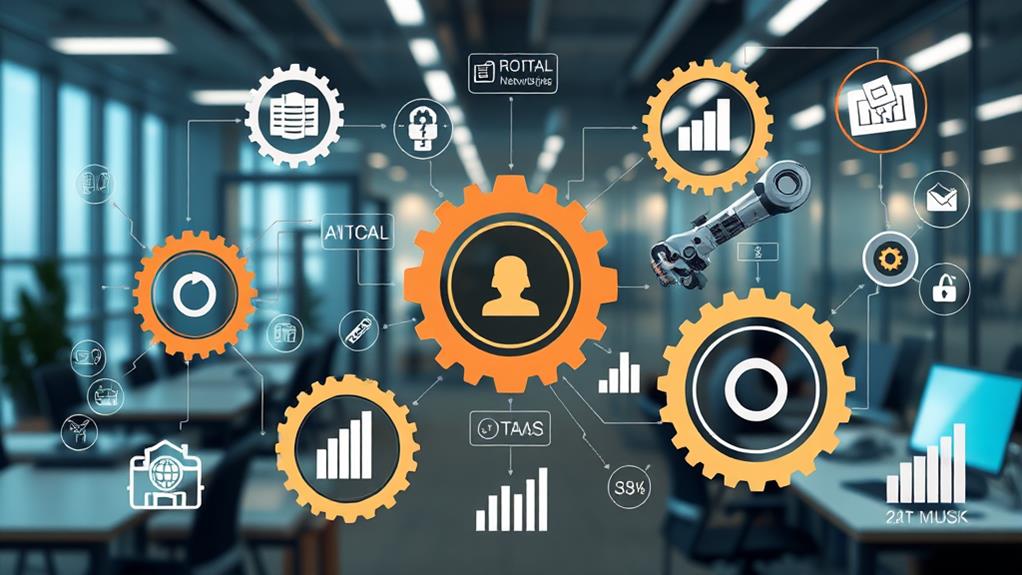CFOs are increasingly turning to process mining to enhance returns on Robotic Process Automation (RPA) investments, addressing the complexity and inefficiencies often encountered in finance processes. Process mining offers granular data visualization and workflow optimization, enabling precise identification of bottlenecks and redundant tasks. This integration supports continuous improvement and aligns automation efforts with strategic objectives, resulting in superior data-driven decision-making and enhanced financial performance. Despite technical and change management challenges, process mining stands out as an essential tool for achieving hyper-automation objectives and maximizing RPA value, promising further insights into elevated operational efficiency and agility.
Table of Contents
Key Takeaways
- Process mining boosts RPA effectiveness through data visualization and workflow optimization.
- CFOs recognize process mining’s role in identifying inefficiencies for precise RPA deployment.
- Integration of process mining with RPA enhances decision-making and operational agility.
- Real-time monitoring via process mining drives continuous improvement in RPA strategies.
- Process mining helps finance departments maximize ROI from RPA investments.
RPA Adoption Trends Among CFOs

Finance leaders are doubling down on the adoption of Robotic Process Automation (RPA) as a cornerstone of their digital transformation strategies, with 80% advocating for accelerated implementation of digital technologies by 2025.
RPA scalability strategies are increasingly prioritized, reflecting CFO technology preferences aimed at achieving hyper-automation objectives. Despite current RPA investments falling short in value realization for finance departments, leaders recognize the need for a broader technology toolkit.
Reporting automation, RPA, and process mining are earmarked for increased funding, with reporting automation currently providing the highest value. CFOs are advised to explore complementary technologies, as complexities in finance processes necessitate enhanced solutions to maximize automation outcomes and achieve long-term strategic goals.
Current Value of RPA Investments
Despite significant investments in Robotic Process Automation (RPA), many CFOs have found that the returns on these investments have not met their expectations.
A thorough RPA investment evaluation reveals that only reporting automation currently delivers high value, leaving a gap in the broader application of RPA.
This RPA value assessment indicates that the complexity of finance processes often limits the technology’s effectiveness.
Data from 2022 shows that while 80% of finance leaders advocate for accelerated digital tech implementation, the actual value realized from RPA remains suboptimal.
CFOs are increasingly recognizing the need for a more diversified technology toolkit to achieve their hyper-automation objectives, suggesting that additional complementary technologies are essential for enhancing overall automation returns.
Understanding Process Mining

In the domain of finance and automation, process mining emerges as a pivotal tool for enhancing operational efficiency and driving data-driven decision-making.
Process mining leverages event logs from IT systems to perform data visualization and workflow optimization. This methodology enables the discovery, monitoring, and enhancement of business processes by providing actionable insights into process execution.
The three core functions—discovery, conformance, and enhancement—help identify inefficiencies and exceptions in real-time. CFOs are increasingly adopting process mining to gain a granular understanding of workflows, which facilitates precise optimization and guarantees alignment with organizational objectives.
This approach not only enhances transparency but also empowers finance leaders to make informed decisions, ultimately leading to improved financial performance and operational agility.
Enhancing RPA With Process Mining
Leveraging the analytical power of process mining can considerably amplify the effectiveness of Robotic Process Automation (RPA) initiatives.
By utilizing data visualization, process mining offers granular insights into workflow optimization, enabling CFOs to pinpoint inefficiencies and streamline operations. This data-driven approach facilitates the identification of bottlenecks and redundant tasks that can be addressed through targeted RPA deployment.
Consequently, organizations can achieve more precise automation, reducing operational costs and enhancing overall productivity.
Additionally, the real-time monitoring capabilities of process mining guarantee continuous improvement, allowing for dynamic adjustments to RPA strategies.
This synergistic integration ultimately leads to a more agile and responsive business environment, aligning automation efforts with strategic objectives.
Benefits of Integration

Integrating process mining with Robotic Process Automation (RPA) presents numerous strategic advantages, fundamentally enhancing automation outcomes. In essence, the combination of process mining and RPA allows organizations to gain deeper insights into their existing processes, identify areas for improvement, and effectively design automated solutions that align with their business goals. By leveraging the power of process mining to analyze and optimize processes, RPA can then be deployed to streamline and automate repetitive tasks, resulting in significant cost savings and increased operational efficiency. Ultimately, this synergy maximizes process automation benefits by ensuring that automated processes are not only efficient but also optimized to deliver the greatest value to the organization.
This synergy offers superior data visualization and workflow optimization, driving substantial value for finance departments. By leveraging process mining, CFOs can gain thorough insights into process inefficiencies and streamline operations with precision. By harnessing the power of automation, finance departments can automate repetitive tasks and allocate resources more effectively. This not only improves operational efficiency but also enables finance teams to focus on strategic decision-making and value-added activities. Additionally, the combination of process mining and automation empowers CFOs to identify bottlenecks and areas for improvement, ultimately leading to significant cost savings and enhanced productivity.
The integration guarantees that RPA initiatives are data-driven and targeted, maximizing return on investment.
- Data visualization: Provides a clear, actionable view of current processes, highlighting inefficiencies and bottlenecks.
- Workflow optimization: Enables continuous improvement by identifying and addressing process deviations in real-time.
- Enhanced decision-making: Empowers CFOs with data-backed insights, facilitating informed choices and strategic planning.
This approach not only reduces operational costs but also enhances agility in dynamic markets.
Implementation Challenges
Despite the strategic benefits of integrating process mining with RPA, several implementation challenges can impede progress. A primary concern is ensuring data quality, as inaccurate or inconsistent data can lead to flawed analyses and suboptimal automation outcomes.
The complexity of integrating process mining tools with existing systems also poses technical difficulties, requiring significant IT expertise. Additionally, effective change management is vital to overcoming resistance from employees accustomed to traditional processes.
Organizations must invest in training and development to build the necessary skills for analyzing and interpreting process data. Furthermore, initial investment costs can be prohibitive, particularly for smaller firms, further complicating adoption.
Addressing these challenges is essential for maximizing the ROI from combined process mining and RPA initiatives.
Future Trends in Process Mining

Addressing the implementation challenges is fundamental to guaranteeing the success of process mining initiatives.
Future trends in process mining indicate significant advancements, particularly in real-time monitoring and predictive analytics. Integrating AI and machine learning will enable predictive analytics, providing deeper insights and more proactive decision-making.
Enhanced real-time monitoring capabilities will guarantee continuous process optimization and swift anomaly detection.
Key trends to watch:
- AI Integration: Leveraging machine learning for predictive analytics in process mining.
- Real-Time Monitoring: Continuous improvement through real-time data analysis.
- New Tools and Platforms: Emergence of innovative solutions enhancing process mining capabilities.
These trends underscore the importance of staying ahead in technology adoption to maximize RPA returns and streamline finance processes effectively.
Frequently Asked Questions
How Do CFOS Measure the ROI of Process Mining Investments?
CFOs measure the ROI of process mining investments using metrics such as cost savings, performance improvement, data accuracy, and process efficiency. Investment analysis and strategic alignment with technology adoption goals are essential for accurate ROI assessment.
What Are the Initial Steps to Integrate Process Mining With Existing Systems?
To integrate process mining with existing systems, begin with robust data integration strategies, ensuring seamless data flow. Next, prioritize tool selection by evaluating compatibility and functionality to align with organizational objectives, thereby enhancing efficiency and automation outcomes.
How Can Companies Overcome Employee Resistance to Process Mining Adoption?
To overcome employee resistance to process mining adoption, companies should implement robust change management strategies, emphasizing employee engagement through transparent communication, thorough training, and demonstrating the tangible benefits of process improvements derived from data-driven insights.
Which Industries Benefit the Most From Process Mining and RPA Integration?
Industries experiencing unparalleled transformation through process mining and RPA integration include healthcare optimization, manufacturing efficiency, retail analytics, and financial forecasting. These sectors leverage data-driven insights to enhance operational control, precision, and strategic decision-making.
What Training Programs Are Available for Upskilling Staff in Process Mining?
Several training programs are available for upskilling staff in process mining, including process mining certification courses and data analysis workshops. These programs provide technical expertise, ensuring employees can effectively implement and analyze process mining tools for ideal results.
Conclusion
Process mining, paired with RPA, presents a promising paradigm for CFOs aiming to amplify automation efficiency. This synergy fosters superior scrutiny and streamlines workflows, unblocking unparalleled potential for process optimization. By bridging the gap between current automation achievements and anticipated ROI, process mining emerges as an essential element in the evolving financial technology ecosystem. However, stakeholders must navigate implementation intricacies to fully harness these benefits, ensuring sustained operational success and strategic agility in future financial frameworks.






